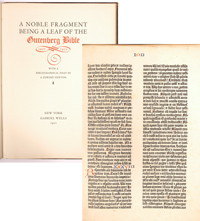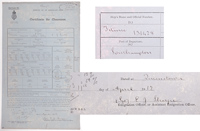
|
Sale 56
Manuscript, Collectibles and Aerospace Auction
| Lot |
Photo |
Description |
Realized |
Lot 1 |
 |
[Gutenberg Bible Leaf From the Book of Job]. Printed leaf, double folio, 4 columns (2 each front and back), each column with 42 lines, being part of chapter 37 and all of chapters 38 and 39. Printed by Johann Gutenberg (Mainz, Germany), c. 1450-1455. With hand rubrication. Presented in a black leather portfolio case with the title: A Noble Fragment Being A Leaf of the Gutenberg Bible. 1450-1455 With A Bibliographical Essay By A. Edward Newton. New York Gabriel Wells 1921. The Bible leaf is attached with archival tape on the verso at the left margin to a slightly larger sheet in the portfolio. The Bible sheet is toned and has marginal soiling; paper filler was added to blank lower right margin
The Gutenberg Bible is a printed version of the Latin Vulgate. It was the first major book to be printed with movable type. It is thought that Gutenberg printed approximatey 180 copies: 145 on paper and the remainder on vellum. Either 47 or 48 of the 42-line Bibles are known to exist today but only 21 of them are complete. Even at the time they were printed, they were prohibitively expensive and probably only within the financial reach of churches and monasteries.
Job is the first of five books commonly referred to as "The Books of Poetry" because they are written in poetic style, rather than the narrative style of most other books. These include Job, Psalms, Proverbs, Ecclesiastes, and the Song of Solomon. The Book of Job addresses the issue of why God allows the righteous to suffer; it has long been praised as a masterpiece of literature. Victor Hugo said, "Tomorrow, if all lliterature were to be destroyed and it were left to me to retain one work only, I should save Job." Tennyson called it "…the greatest poem, whether of acient or modern literature," and Daniel Webster said, "The book of Job taken as a mere work of literary genius, is one of the most wonderful productions of any age or of any language."
This sheet begins in Chapter 37 with the verse: "By the breath of God frost is given: and the breadth of the waters is straitened."
Chapter 38 begins: "Then the Lord answered Job out of the whirlwind, and said, Who is this that darkeneth counsel by words without knowledge? Gird up now thy loins like a man; for I will demand of thee, and answer thou me."
Estimated Value $60,000 - 80,000.
View details and enlarged photo
| Realized
$82,250 |
Lot 2 |
 |
Titanic Certificate for Clearance, Dated April 11, 1912. Certificate for Clearance issued by the Board of Trade, being a blue, partly-printed form, "Surveys 32. Survey Of An Emigrant Ship," which was accomplished in manuscript by E.J. Sharpe, the "Emigration Officer or Assistant Emigration Officer," 1 page, 13¼ x 8 in., Queenstown (Ireland), April 11, 1912. The emigration officer certifies that all of "the particulars inserted in the above form are correct…that all the requirements of the Merchant Shipping Acts relating to emigrant ships…have been complied with, and that the ship is, in my opinion, seaworthy, in safe trim, and in all respects fit for her intended voyage…."
The certificate gives the name of the ship: "Titanic; the port of registry: Liverpool; the name of the master: E.J. Smith; the port of departure: Southampton; the ports of call: Cherbourg and Queenstown; and the destination: New York. The total number of cabin passengers who embarked at the three ports of call totaled 606; steerage passage totaled 710, and the total crew numbered 892, for a total of 2208 people on board.
Although we think of the Titanic as a luxury liner, she was considered an "Emigrant Ship," as was any British ship which carried more than 50 steerage passengers (people traveling without cabins) and which was sailing to a port outside Europe. In addition to a Certificate of Registry, the ship had to be inspected by the Board of Trade's Surveyor's Office and a Surveys 27 form completed, certifying the ship to be seaworthy and carrying adequate life-saving equipment. Also, the Emigration Officer at each port where the ship took on passengers had to fill out a Surveys 32 form, certifying that the ship was seaworthy and met all of the legal requirements and that "her passengers and crew are in a fit state to proceed."
This Surveys 32 form was issued at Queenstown, Ireland, the Titanic's last port of call before she started her journey across the Atlantic and four days before she hit an iceberg and sank. A docket at upper right reads, "Board of Trade Surveyor's Office No 408 13 Apr 1912 Queenstown," and at top center, in the same hand, is "[Copy]". This was the copy retained by the Emigration Office in Queenstown; the form carried by the Titanic was lost with the ship, as was the original Certificate of Registry. There are later penciled notations made by someone from the Emigration Office, one of them adding up the steerage passengers (710) and noting, "176 saved." and other notes at lower left.
We know of no other existing, official documentation for the Titanic. This is truly a historic document.
Estimated Value $25,000 - 50,000.
View details and enlarged photo
| Unsold |
|
|